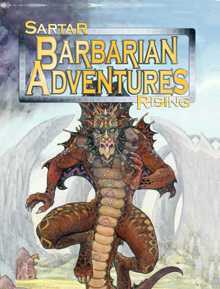|
Sartar Rising: Barbarian Adventures is the first setting and scenario campaign book for Hero Wars. When I ordered the book I was interest to see how scenarios were organized and presented. I was surprised to find that the first 2/3rds of the book is really setting information, discussing the tribal history of the Orlanthi, the geography of Dragon Pass, & the daily lives of the Orlanthi people. The information in the book dovetails with the information in Thunder Rebels, which is designed to be a companion piece. The text also points to Anaxial’s Roster and Storm Tribe.
The purpose for providing this extensive information about the daily and yearly lives of the Orlanthi people is that the designer wants you to spend the first part of your campaign experiencing normal life among the barbarians, going through the calendar and all its religious holy days. Rather than providing a set of scenarios, the book provides story seeds and starting points to locate where the dramatic possibilities are within the usual goings on. I found this unusual approach quite exciting because it is founded in discovery through play and the importance of community to who will one day be heroes of this world. The seeds pose problems and pressures for the narrator to present without any solution being required and pushed for. It is purely to see how the player’s react. Some seed ideas are “A priest complains that the leader has offended the gods,” “competition threatens a crucial trade relationship,” or this one: “Several sheep are found slaughtered in the fields. It was not outlaws or fugitives, because they are butchered the wrong way. It was not Telmori, because knives were used. It was not trolls, because there is some left. It must have been Lunars. They killed more than they needed, and a lot was left behind to feed foxes and flies. A Waste.” It is from these little incidences that the narrator can see what the characters care about and over what they will jump to action. Stringing a number of these event together, a larger picture of the world will come into focus, and it will all develop through play and discovery. It’s a surprisingly wide-open approach to campaign play and it made me want to play the game more than anything I’d read up to that point. There is a long game at play, which we learn in the second campaign book, Orlanth is Dead! That book, the same length as the first, has only one chapter with a single detailed scenario. That one scenario is the thing that launches the Hero Wars, the war for which the game is named. After the players have played through a normal year, Orlanth is Dead details half a year in which everything has gone awry, as the Lunars have apparently killed Orlanth himself. There is no wind and no magic for the worshippers of Orlanth. Little seeds again make up the bulk of play as villages go hungry and descend into panic and rebellion. It all leads up to the one scenario, which is nothing more than an extended battle sequence. But if you don’t know where this is going when you read the first Barbarian Adventures, it seems like a refreshingly odd take on a campaign. And once I understood what the game was doing, I appreciated the approach even more, because you could shape your world in any way you want over the last year and half of the calendar, as long as the Lunars weren’t defeated, and by keeping the scope so close to the local community, that couldn’t happen anyway. So by the time the “metaplot” arrives, the players have made Glorantha and Dragon Pass their own in ways that the metaplot doesn’t feel like it is decided from on high. Or at least that’s the goal, I think. By the time Sartar Rising: Barbarian Adventures was published in late 2001, Issaries seemed to have worked out all their bugs, because this is the most beautifully laid out of the texts and the best looking of them.
0 Comments
Leave a Reply. |
Jason D'AngeloRPG enthusiast interested in theory and indie publications. Archives
April 2023
Categories |

 RSS Feed
RSS Feed